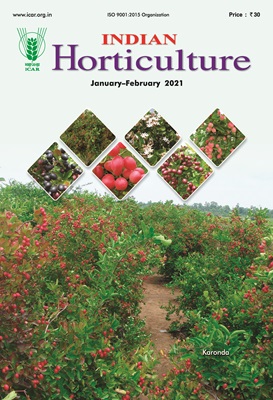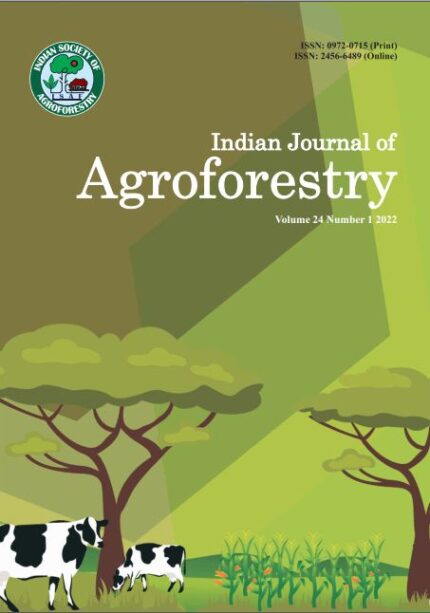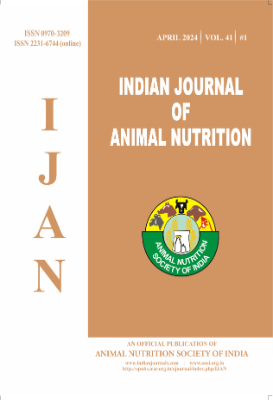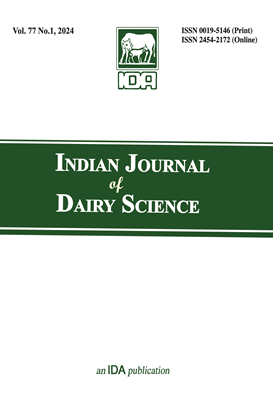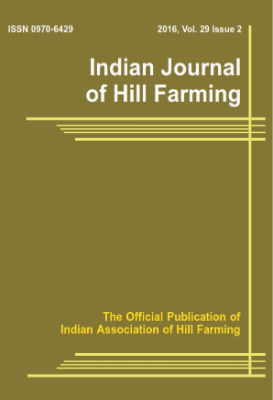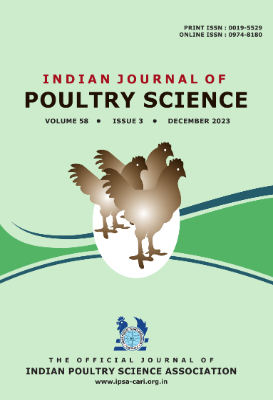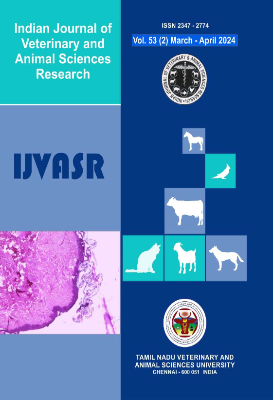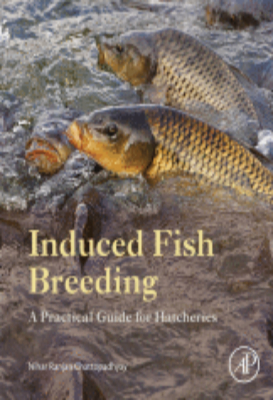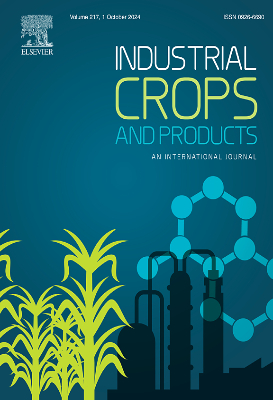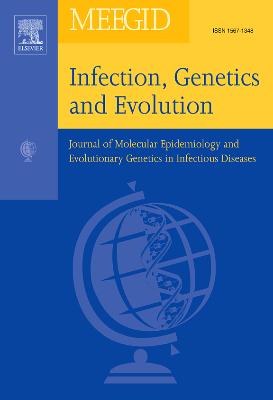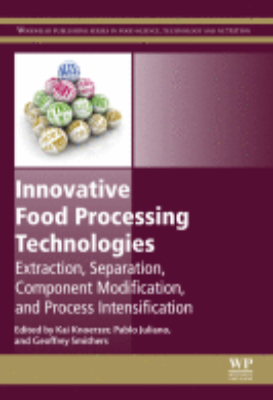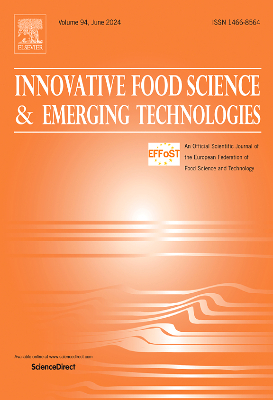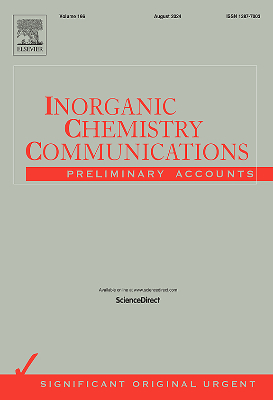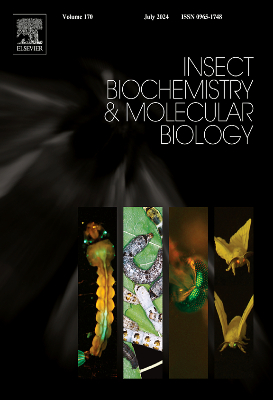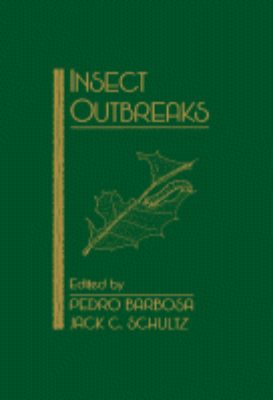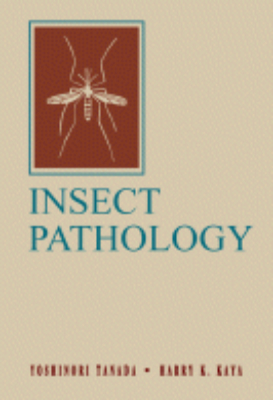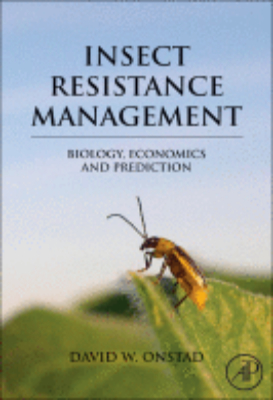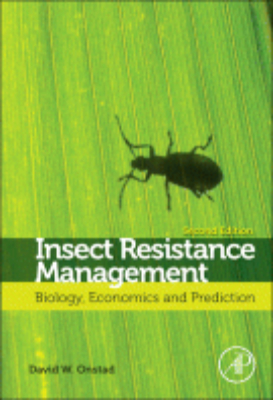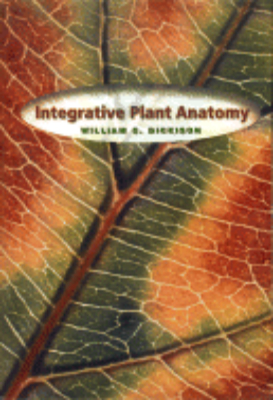Agricultural Science
Indian Journal of Agroforestry
Focus and Scope The Indian Journal of Animal Production and Management publishes original research and review papers in all applied aspects of animal production management. Peer Review Process Double-blind reviewing procedure is followed for each paper. Publication Frequency The journal is published quarterly (4 issues per year). Ethics Policy Manuscripts submitted to the journal are evaluated on the basis of their scientific content. Measures are adopted to uphold the standards of publication ethics and to avoid malpractices. We ensure that the papers submitted and their work is original and unpublished, and is not submitted for publication elsewhere. In addition, authors certify that their research paper is their own original work, that is neither copied or plagiarized, partly or whole, from other works, and that the works of others are appropriately cited or quoted. Open Access Policy This is an open access journal which means that all content is freely available without charge to the user or his/her institution. Users are allowed to read, download, copy, distribute, print, search, or link to the full texts of the articles, or use them for any other lawful purpose, without asking prior permission from the publisher or the author. This is in accordance with the BOAI definition of open access. Licence Attribution-NonCommercial 4.0 International (CC BY-NC 4.0) Copyright Notice Copyright lies with the publisher. Privacy Statement The names and email addresses entered in this journal site will be used exclusively for the stated purposes of this journal and will not be made available for any other purpose or to any other party. Archiving All published journal content shall be automatically preserved in the PKP Preservation Network (PKP|PN). Sponsors Indian Society of Animal Production and Management Journal History The journal was started in the year 1986 by the Indian Society of Animal Production and Management with aim to publish original research work in the area of livestock production management. The first issue was published in the year 1986 by Department of Livestock Production and Management, Haryana Agricultural University, Hisar, Haryana. The founder editor of the Journal was Dr. N. S. R. Sastry.
Indian Journal of Animal Nutrition
Focus and Scope The Indian Journal of Animal Nutrition (IJAN) publishes original papers on research in the fields of animal nutrition, feed technology, feed evaluation and conservation, physiological and biochemical aspects including microbiology, biotechnology, feed and fodders and other relevant areas related to livestock feeding in developing and tropical regions. Papers describing research on given areas for ruminants and non-ruminants are welcome. The Journal is a forum for presenting peer reviewed articles on basic and applied research. Submissions addressing the new frontiers of the subject including emerging areas of nutritional genomics, modelling and interface topics such as soil plant animal and ecosystem interrelationships are given priority. Reviews on specialized topics are also included. The IJAN is published quarterly since its inception in 1983 under the aegis of Animal Nutrition Society of India (ANSI) having about twelve hundred life members around the world. ANSI has instituted two awards to be given to two selected papers published in the Journal during the biennial conferences. Peer Review Process All the manuscripts are submitted to chief editor and thereafter sent for evaluation/comments/recommendations by two referees. The papers are processed as per the recommendations of the referee and editorial board. The papers are rejected if not found suitable for publication or out of scope of Journal. Publication Frequency The journal is published quarterly. Open Access Policy This journal provides immediate open access to its content on the principle that making research freely available to the public supports a greater global exchange of knowledge. Sponsors 1984 Indian Council of Agricultural Research Journal History IJAN is published quarterly since its inception in 1983 under the aegis of Animal Nutrition Society of India (ANSI), having more than one thousand life members around the world.
Indian Journal of Dairy Science
Indian Journal of Dairy Science is a scientific journal of Indian Dairy Association. The objective of the Association shall be the advancement of dairy science and industry, farming, animal husbandry, animal sciences and its branches including dairy farming & research on breeding, and management of dairy livestock.
Indian Journal of Extension Education
The Indian Journal of Extension Education is the open access, indexed, and peer- reviewed official publication of the Indian Society of Extension Education (ISEE), Division of Agricultural Extension, ICAR- Indian Agricultural Research Institute, New Delhi 110012, INDIA. The focus subject areas of the Indian Journal of Extension Education include; Agricultural Extension, Agricultural Communication, Agricultural Entrepreneurship, Extension Management, Agricultural Education, Socioeconomic Studies, Rural Sociology and educational Psychology, Adoption and diffusion of Farm Innovations, Agricultural Diversification, ICT application in Agriculture, Planned Agricultural Change, Agricultural & Rural Development, and Contemporary Agricultural Extension issues related to Agricultural Science/ Dairying / Communication/ Home Science / Fisheries / Veterinary and allied social sciences. The Indian Journal of Extension Education publishes peer-reviewed original manuscripts in the field of extension education and allied fields. The journal accepts original research papers, research tools, and research notes only. The Indian Society of Extension Education, New Delhi is the publisher of the Indian Journal of Extension Education.
Indian Journal of Hill Farming
Focus and Scope The Indian Journal of Hill Farming (Indian J Hill Farming) is the official organ of the Indian Association of Hill Farming, Umiam, Meghalaya, India and is devoted to original research report on all aspects of Agriculture, Animal Husbandry, Fisheries, Forestry, Ecology and other related fields of biology pertaining to Hill Farming. The Journal published twice a year, includes communications in form of research papers, review papers, short notes and book reviews, primarily from members. In addition, articles of exciting research and general interest are also accepted for publication. However, popular articles are generally not accepted. Every issue also contains some review articles on actual problems / future research possibilities / status of research, education and development. All contents are in the English language and subject to peer review. Peer Review Process All manuscripts are reviewed by an editor and/ members of the Editorial Board to assess whether the manuscript is fit for outside review. Generally, manuscripts are sent to two reviewers, and if required, to a third reviewer. Decisions will be made as rapidly as possible, and the journal strives to return reviewers? comments to authors within 4 ? weeks. Manuscripts sent to authors for revision should be returned within 2 weeks; otherwise, they will be treated as new submissions. The Editorial Board including copy editors will re-review manuscripts that are accepted pending revision. Best efforts are made to publish manuscripts online within 8 weeks after submission. Open Access Policy IJHF will be published freely online (till the December 2013 issue). Authors can freely download the PDF file from which they can print unlimited copies of their articles. From June 2014 issue, full text would be available to members only. Members would be asked to register and obtain login details. Individual articles can be downloaded by non-members on payment basis. Sponsors Indian Association of Hill Farming Journal History The journal was first published in the year 1987. The journal is published twice a year (June and December). Current NAAS rating of the Journal is 2.9
Indian Journal of Poultry Science
Established in 1965, Indian Journal of Poultry Science (IJPS), a leading peer-reviewed Indian journal in the field is an official publication of the Indian Poultry Science Association (IPSA), Izatnagar-243 122 (UP). The publication is aimed at providing access to academicians, researchers and industry professionals from across the globe to publish their work on all aspects of poultry science through research papers, short communications and review articles. The journal is published three times in a year as one volume in April, August, and December and circulated to IPSA members free of cost. Till date 58 volumes each with 3 issues have been published.
Indian Journal of Veterinary and Animal Sciences Research
Focus and Scope The Indian Journal of Veterinary and Animal Sciences Research published six times (bi-monthly) in a year, considers original papers for publication on all aspects of Veterinary, Animal, Fisheries, and Food sciences (related to animal products). Peer Review Process In the first phase, the suitability of the manuscript received through the online epubs portal of ICAR will be assessed by the experts on the editorial board of the journal. The qualified manuscripts will be made anonymous and sent to two referees at the national level for review. The manuscripts corrected by referees are sent back to the author for revision. The corrected manuscript will be reviewed by the Editorial Board and technically qualified manuscripts will be accepted and scheduled for publication. Open Access Policy This journal provides immediate open access to its content on the principle that making research freely available to the public supports a greater global exchange of knowledge. Sponsors Tamil Nadu Veterinary and Animal Sciences University, Chennai 600 051 Journal History The Indian Journal of Veterinary and Animal Sciences Research (IJVASR) has been published since 1972, initially under the name 'Cheiron' until 2005, and later as the 'Tamil Nadu Journal of Veterinary and Animal Sciences'. In 2014, the journal adopted its current name to reflect its national relevance and improve visibility. In its current format, IJVASR now publishes review articles, peer-reviewed research articles, short communications, and case reports.
Indian Journal of Veterinary Medicine
Focus and Scope Indian Journal of veterinary Medicine published twice in a year The journal publishes review article(invited),original /applied research, clinical reports short communications on all area of animal health including diagnosis treatment and control. Peer Review Process All articles submitted for publication under goes a peer review process by the expert reviewer of the area. To make the review process more transparent Authors name and affiliation were keep in confidence. Based on the comments the articles are either revised or rejected. The revised article further examined by the editorial board. Journal History This Journal is being published regularly since 1981.
Induced Fish Breeding
"Induced Fish Breeding: A Practical Guide for Hatcheries takes a successive approach to explaining the use of breeding technology with proven scientific methods. It provides real-life examples for the purpose of maximizing fish and seed production to support overall sustainability in aquaculture. It is a concise reference to understanding the latest developments in the field, useful for anyone who is involved in fisheries or hatchery management as well as researchers and students who need to understand the technology. A practice originally developed to produce quality seed in captivity, induced breeding has made great strides in fish populations for India. The book offers a practical and succinct overviewfrom existing methods and operations to recent trends and their impacts on aquaculture for the future. Key Features. Provides detailed information about empirical breeding practices like mixed spawning and indiscriminate hybridization. Presents the environmental and hormonal influence on maturation and spawning of fish with real-life fish breeding examples from around the world. Includes step-by-step scientific measures to help solve problems arising from common fish-farming mistakes. Provides real-life examples for the purpose of maximizing fish and seed production to support overall sustainability in aquaculture"
Innovative Food Processing Technologies
"Innovative Food Processing Technologies: Extraction, Separation, Component Modification and Process Intensification focuses on advances in new and novel non-thermal processing technologies which allow food producers to modify and process food with minimal damage to the foodstuffs. The book is highly focused on the application of new and novel technologies, beginning with an introductory chapter, and then detailing technologies which can be used to extract food components. Further sections on the use of technologies to modify the structure of food and the separation of food components are also included, with a final section focusing on process intensification and enhancement. Key Features. Provides information on a variety of food processing technologies. Focuses on advances in new and novel non-thermal processing technologies which allow food producers to modify and process food with minimal damage to the foodstuffs. Presents a strong focus on the application of technologies in a variety of situations. Created by editors who have a background in both the industry and academia"
Inorganic Nutrition of Plants
Plant Physiology, Volume III: Inorganic Nutrition of Plants deals with the inorganic nutrition and metabolism of plants. The book explores the role of elements, other than carbon, hydrogen, and oxygen, which are essential to, or used by, plants in their vital processes. It summarizes the knowledge about mineral nutrition of plants and presents a philosophy of plant nutrition in general. This volume is organized into six chapters and begins with a brief history of mineral nutrition of plants, as well as the media from which plants draw their nutrients, such as the soil and artificial culture medium. The book then discusses the requirements for specific elements, the symptoms incurred by their deficient supply, and the evidence that a given element can be considered essential. The next chapters focus on the inorganic nutrition of microorganisms, general functions of the essential nutrient elements, and the biological situations in which elementary nitrogen is converted to the organic form. The book concludes by analyzing the soil as a complex biological system and its implication for the interpretation of the nutrition of higher plants. This book is a valuable resource for those interested in plant nutrition and plant physiology.
Insect Outbreaks
FROM THE PREFACE: The abundance of insects can change dramatically from generation to generation; these generational changes may occur within a growing season or over a period of years. Such extraordinary density changes or "outbreaks" may be abrupt and ostensibly random, or population peaks may occur in a more or less cyclic fashion....The goal of this book is to update and advance current thinking on the phenomenon of insect outbreaks. The contributors have reviewed relevant literature in order to generate a synthesis providing new concepts and important alternatives for future research. More importantly, they have presented new ideas or syntheses that will stimulate advances in thinking and experimentation.
Insect Pathology
Insect Pathology is designed for a broad spectrum of readers. Is should be useful to students, lecturers, and researchers requiring information about the principles in insect pathology and the biology of pathogens. It should serve as a resource for specialists to learn about other insect pathogen systems, for generalists to become aware of advances in insect pathology, and for scientists and students, beginning or otherwise, interested in learning about insect pathology.. This book was originally intended to update the 1949 test by E. A. Steinhaus entitled Principles of Insect Pathology. The purpose for this book was twofold: To serve (1) as a text for an insect pathology and/or biological control class and (2) as a comprehensive reference source. Because this book summarizes much of the available information, its usefulness as a textbook for an insect pathology class is apparent. Although the literature citations are extensive, they are far from complete. The literature in insect pathology is voluminous and for the past decade has been expanding at an almost exponential rate. A complete review of the literature is beyond the scope of the book, and an omission of a reference does not preclude its importance. Our citations, however, should serve as a good starting point for those who wish to obtain further information. We have attempted to cover equally all subdisciplines, but shortcomings are unavoidable. For these, we take full responsibility.
Insect Pests of Potato
"Insect Pests of Potato: Biology and Management provides a comprehensive source of up-to-date scientific information on the biology and management of insects attacking potato crops, with an international and expert cast of contributors providing its contents. This book presents a complete review of the scientific literature from the considerable research effort over the last 15 years, providing the necessary background information to the subject of studying the biology management of insect pests of potatoes, assessment of recent scientific advances, and a list of further readings. This comprehensive review will be of great benefit to a variety of scientists involved in potato research and production, as well as to those facing similar issues in other crop systems. Key Features. Written by top experts in the field, this is the only publication covering the biology, ecology and management of all major potato pests. Emphasizes ecological and evolutionary approaches to pest management. Summarizes information from hard-to-get publications in China, India, and Russia"
Insect Resistance Management: 2007
Insects, mites, and ticks have a long history of evolving resistance to pesticides, host-plant resistance, crop rotation, pathogens, and parasitoids. Insect resistance management (IRM) is the scientific approach to preventing or delaying pest evolution and its negative impacts on agriculture, public health, and veterinary issues. This book provides entomologists, pest management practitioners, developers of new technologies, and regulators with information about the many kinds of pest resistance including behavioral and phenological resistance. Abstract concepts and various case studies provide the reader with the biological and economic knowledge required to manage resistance. No other source has the breadth of coverage of this book: genomics to economics, transgenic insecticidal crops, insecticides, and other pest management tactics such as crop rotation. Dr. David W. Onstad and a team of experts illustrate how IRM becomes efficient, effective and socially acceptable when local, social and economic aspects of the system are considered. Historical lessons are highlighted with new perspectives emphasized, so that future research and management may be informed by past experience, but not constrained by it.
Insect Resistance Management: 2014
"Neither pest management nor resistance management can occur with only an understanding of pest biology. For years, entomologists have understood, with their use of economic thresholds, that at least a minimal use of economics was necessary for proper integrated pest management. IRM is even more complicated and dependent on understanding and using socioeconomic factors. The new edition of Insect Resistance Management addresses these issues and much more. Many new ideas, facts and case studies have been developed since the previous edition of Insect Resistance Management published. With a new chapter focusing on Resistance Mechanisms Related to Plant-incorporated Toxins and heavily expanded revisions of several existing chapters, this new volume will be an invaluable resource for IRM researchers, practitioners, professors and advanced students. Authors in this edition include professors at major universities, leaders in the chemical and seed industry, evolutionary biologists and active IRM practitioners. This revision also contains more information about IRM outside North America, and a modeling chapter contains a large new section on uncertainty analysis, a subject recently emphasized by the U.S. Environmental Protection Agency. The final chapter contains a section on insecticidal seed treatments. No other book has the breadth of coverage of Insect Resistance Management, 2e. It not only covers molecular to economic issues, but also transgenic crops, seed treatments and other pest management tactics such as crop rotation. Major themes continuing from the first edition include the importance of using IRM in the integrated pest management paradigm, the need to study and account for pest behavior, and the influence of human behavior and decision making in IRM. Key Features. Provides insights from the history of insect resistance management (IRM) to the latest science. Includes contributions from experts on ecological aspects of IRM, molecular and population genetics, economics, and IRM social issues. Offers biochemistry and molecular genetics of insecticides presented with an emphasis on recent research. Encourages scientists and stakeholders to implement and coordinate strategies based on local social conditions"
Integrated Pest Management
"Integrated Pest Management: Current Concepts and Ecological Perspective presents an overview of alternative measures to traditional pest management practices using biological control and biotechnology. The removal of some highly effective broad-spectrum chemicals, caused by concerns over environmental health and public safety, has resulted in the development of alternative, reduced risk crop protection products. These products, less toxic to the environment and easily integrated into biological control systems, target specific life stages or pest species. Predation recognized as a suitable, long-term strategy effectively suppresses pests in biotechnological control systems. Integrated Pest Management covers these topics and more. It explores the current ecological approaches in alternative solutions, such as biological control agents, parasites and predators, pathogenic microorganisms, pheromones and natural products as well as ecological approaches for managing invasive pests, rats, suppression of weeds, safety of pollinators, role of taxonomy and remote sensing in IPM and future projections of IPM. This book is a useful resource to entomologists, agronomists, horticulturists, and environmental scientists. Key Features. Fills a gap in the literature by providing critical analysis of different management strategies that have a bearing on agriculture, sustainability and environmental protection. Synthesizes research and practice on integrated pest management. Emphasizes an overview of management strategies, with critical evaluation of each in the larger context of ecologically based pest management"
Integrative Plant Anatomy
"From this modern and profusely illustrated book, the reader will learn not just the basics, which are amply reviewed, but also how plant anatomy is integrated with a wide variety of other disciplines, such as plant breeding, forensic analysis, medicine, food science, wood and fiber products, and the arts. The author presents the basic concepts and terminology of plant anatomy with a special emphasis on its significance and applications to other disciplines, and addresses the central role of anatomy by consolidating previously scattered information into a single volume. Integrative Plant Anatomy highlights the important contribution made by studying anatomy to the solutions of a number of present and future problems. It succeeds in integrating diverse areas of botany, as well as the non-biological sciences, the arts, and numerous other fields of human endeavor. Key Features. Presents both the classical and modern approaches to the subject. Teaches the importance of the subject to other disciplines such as the nonbiological sciences, the arts, and other fields of human endeavor. Written and organized to be useful to students and instructors, but also to be accessible and appealing to a general audience. Bridges the gap between conventional textbooks and comprehensive reference works. Includes key terms and extensive additional readings. Richly illustrated with line drawings and photographs"



